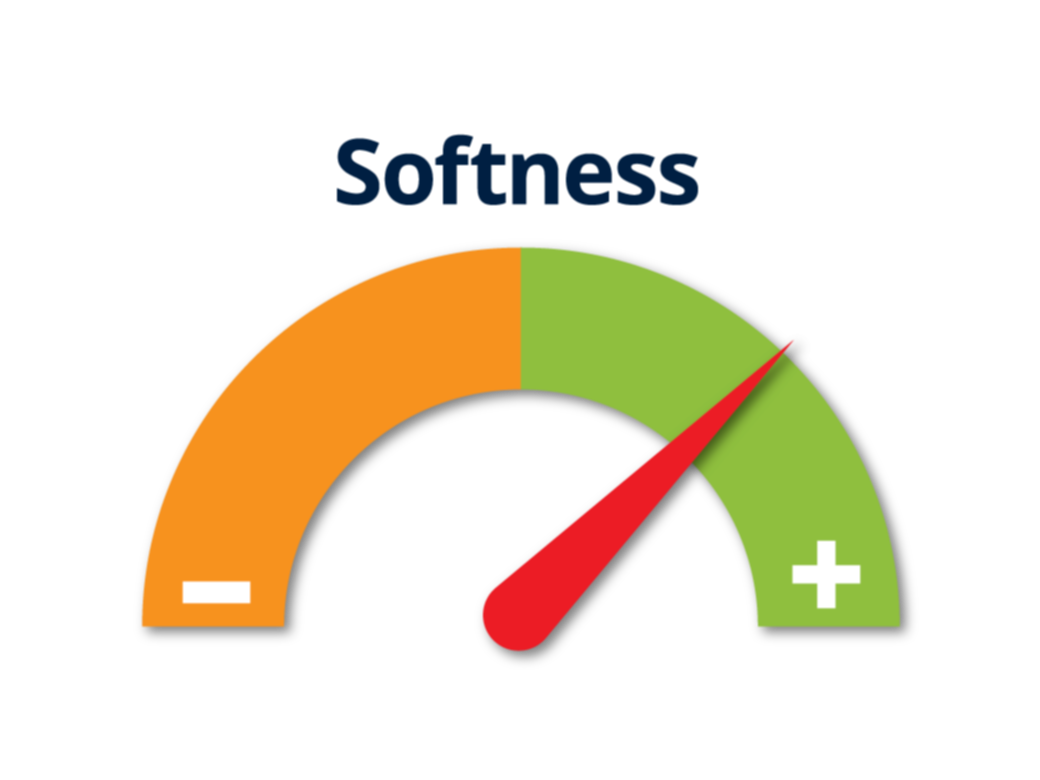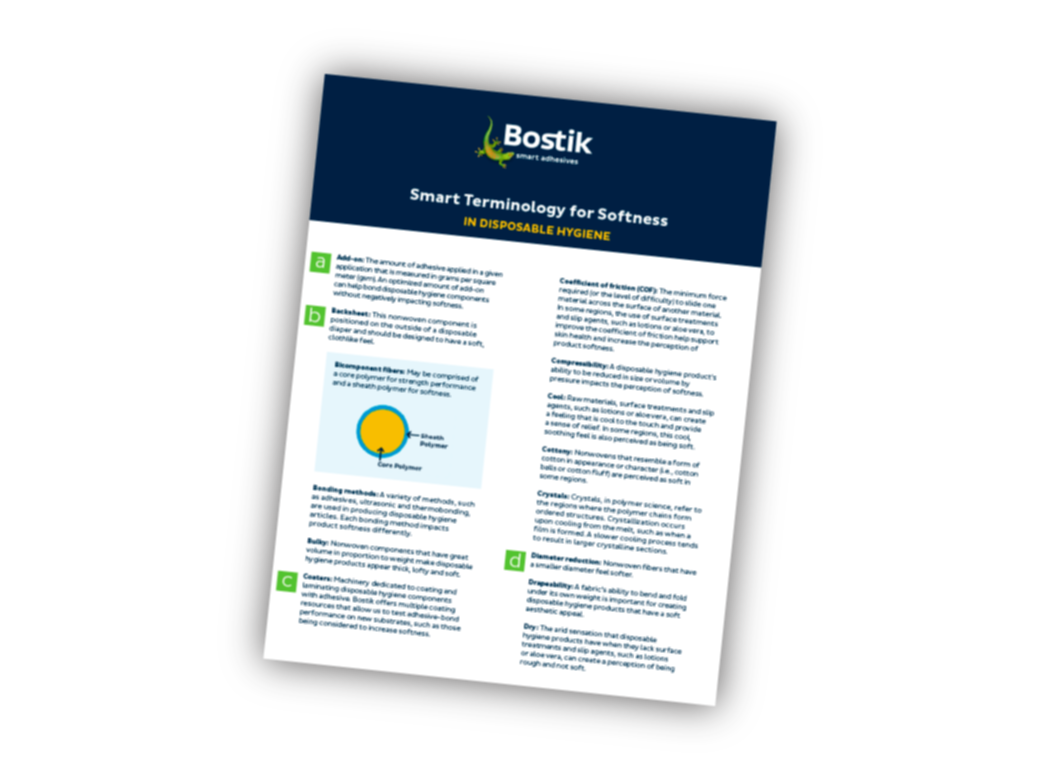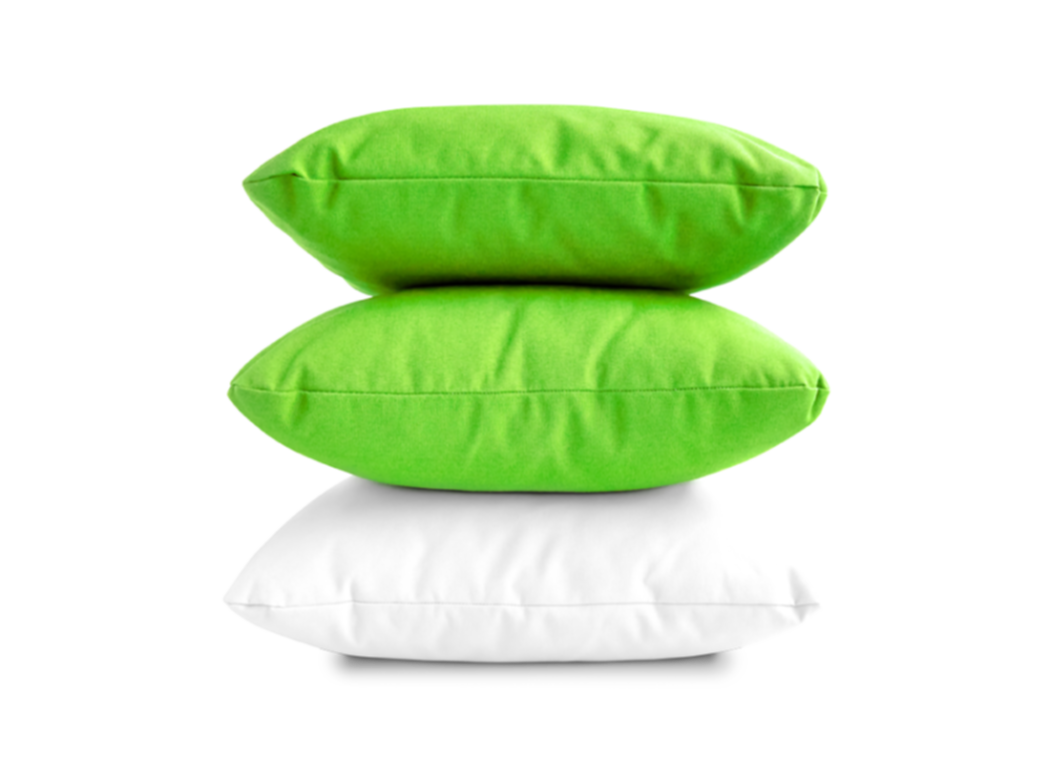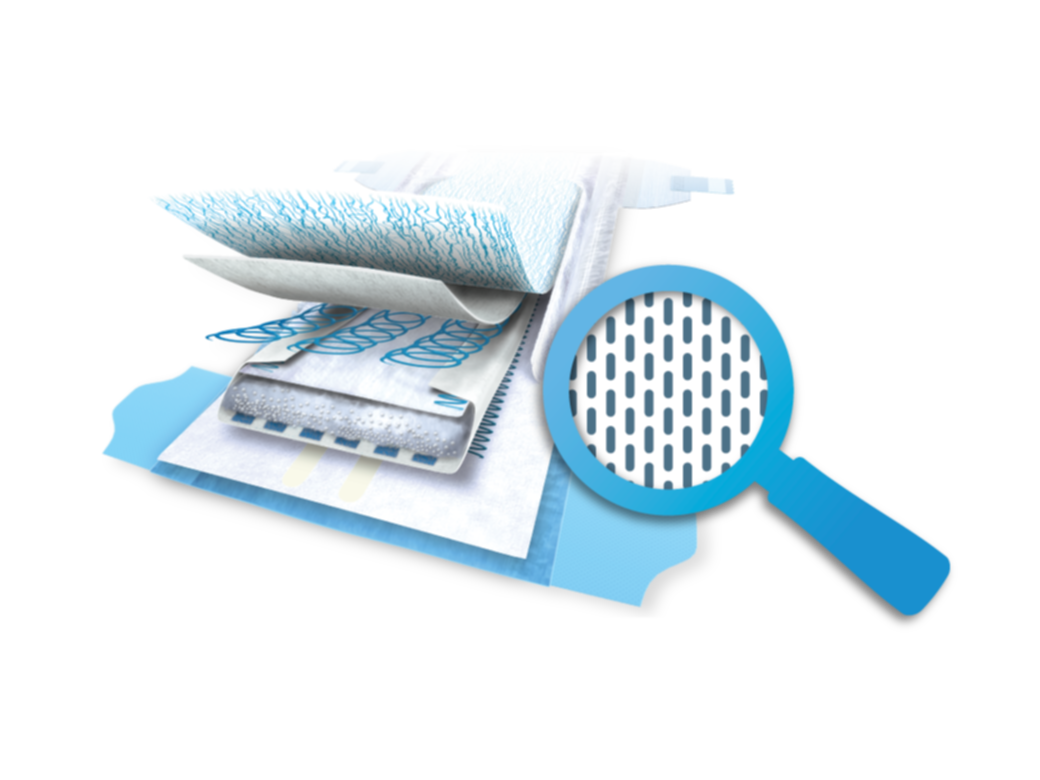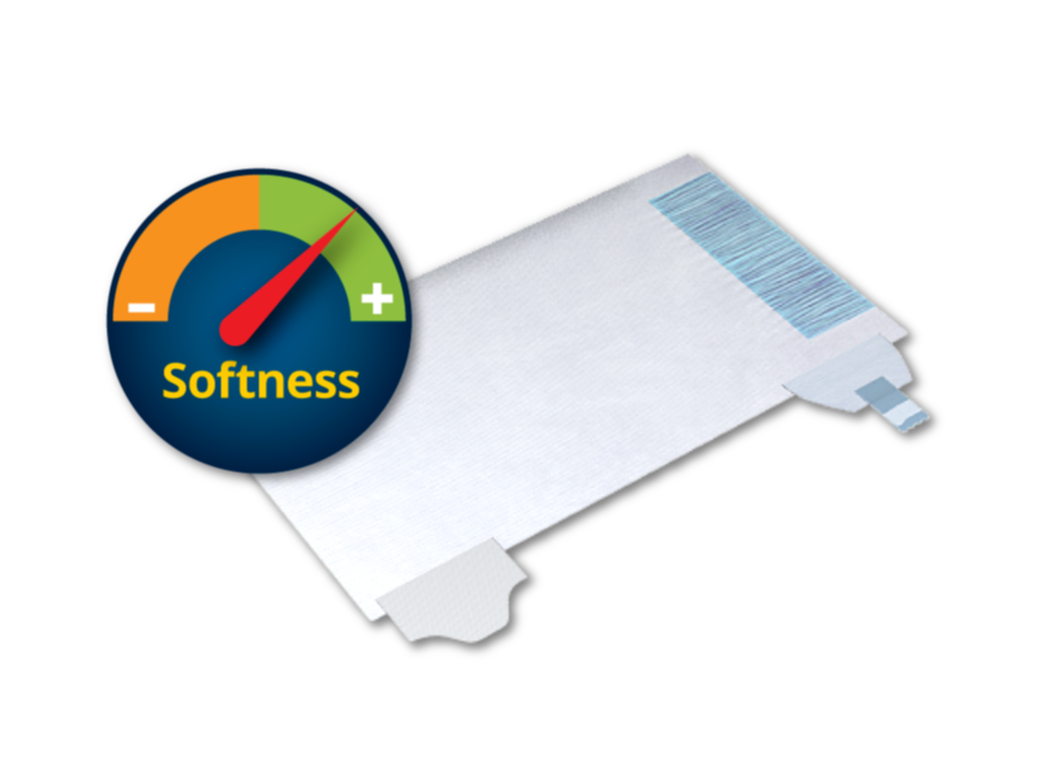Smart Terminology for Softness in Disposable Hygiene
Access a printer-friendly PDF version here.
Add-on: The amount of adhesive applied in a given application that is measured in grams per square meter (gsm). An optimized amount of add-on can help bond disposable hygiene components without negatively impacting softness.
Backsheet: This nonwoven component is positioned on the outside of a disposable diaper and should be designed to have a soft, clothlike feel.
Bicomponent fibers: May be comprised of a core polymer for strength performance and a sheath polymer for softness.
Bonding methods: A variety of methods, such as adhesives, ultrasonic and thermobonding, are used in producing disposable hygiene articles. Each bonding method impacts product softness differently.
Bulky: Nonwoven components that have great volume in proportion to weight make disposable hygiene products appear thick, lofty and soft.
Coaters: Machinery dedicated to coating and laminating disposable hygiene components with adhesive. Bostik offers multiple coating resources that allow us to test adhesive-bond performance on new substrates, such as those being considered to increase softness.
Coefficient of friction (COF): The minimum force required (or the level of difficulty) to slide one material across the surface of another material. In some regions, the use of surface treatments and slip agents, such as lotions or aloe vera, to improve the coefficient of friction help support skin health and increase the perception of product softness.
Compressibility: A disposable hygiene product’s ability to be reduced in size or volume by pressure impacts the perception of softness.
Cool: Raw materials, surface treatments and slip agents, such as lotions or aloe vera, can create a feeling that is cool to the touch and provide a sense of relief. In some regions, this cool, soothing feel is also perceived as being soft.
Cottony: Nonwovens that resemble a form of cotton in appearance or character (i.e., cotton balls or cotton fluff) are perceived as soft in some regions.
Crystals: Crystals, in polymer science, refer to the regions where the polymer chains form ordered structures. Crystallization occurs upon cooling from the melt, such as when a film is formed. A slower cooling process tends to result in larger crystalline sections.
Diameter reduction: Nonwoven fibers that have a smaller diameter feel softer.
Drapeability: A fabric’s ability to bend and fold under its own weight is important for creating disposable hygiene products that have a soft aesthetic appeal.
Dry: The arid sensation that disposable hygiene products have when they lack surface treatments and slip agents, such as lotions or aloe vera, can create a perception of being rough and not soft.
Elasticity: How well a disposable hygiene product can regain its original size and shape after being strained or stretched, especially without cracking or breaking, impacts softness perceptions.
Extrusion coating: Melted polyethylene (PE), which is a synthetic polymer commonly used in disposable hygiene product manufacturing, is directly applied on the nonwoven fabric and pressed between two rolls. This causes the PE to deeply penetrate into the fibers. While the result is a cost-efficient laminate with good strength, it is relatively stiff and limits softness.
Film: Two types of films are typically used to create clothlike backsheets in disposable diapers:
Fluffy: The light and airy appearance of disposable hygiene products that gives a perception of softness.
Handle-o-meter: A machine that measures the “handle” (i.e., combination of surface friction and flexibility) of nonwoven fabrics used in disposable hygiene. The greater the flexibility with reduced friction, the softer the nonwoven fabrics appear.
Hot-melt: This fast-drying nonvolatile adhesive is applied hot in the molten state. It does not negatively impact the feel of softness, drape or the visual appearance of the materials after bonding. Hot melt adhesive polymers traditionally used in the disposable hygiene products include ethylene/vinyl acetate copolymers (EVA), amorphous polyalphaolefins (APAO), styrenic block copolymer (SBC) based adhesives and polyolefin.
Lamination: The process of one substrate being coated with hot-melt and being combined with another substrate between nip rolls. The result is increased softness and reduced noise with good strength and mechanical resistance compared to a product that uses thermabonding.
Loft: The relationship between the air and fiber structure in a nonwoven fabric. Disposable hygiene products made with high-loft fabrics tend to be thick, fluffy and have an appearance of softness.
Nip rolls: Mechanical rollers are used to press two or more sheets together to form a laminated product.
Noisy: Disposable hygiene products that are noticeably heard when removed from the package and during use can be perceived as not being soft because the undesirable sounds they make are often associated with stiff and rigid materials.
Nonwoven: A textile-like material made from short fibers and/or long continuous fibers bonded together by chemical, mechanical or thermal methods.
Oily: In some regions, the excessively slick texture of raw materials, surface treatments and slip agents used in the production of disposable hygiene articles increases the perception of product softness.
Optical effect: How light reflects off a nonwoven fabric fiber generates an optical effect that creates the first impression for softness. The three main shapes for nonwoven fabric fibers are:
Patterns: The geometry of the bonding point for all the layers of a nonwoven fabric. This provides the cohesion while leaving space for the rest of the fabric to remain somewhat “fluffy” and soft. The goal is to create enough bonding points to ensure good cohesion of the fabrics but not too much so that the fabric will still have a good drape and softness. A typical product will have 15-25% of its surface covered by bonding points with either diamond or ovoid shape.
Polymer: Synthetic polymers like polyethylene are often used in disposable hygiene because of their ability to bend and stretch, increasing the perception of softness. Some polymers can also be hard, tough and appear to be less soft.
Rough: Coarse, uneven and rigid surfaces on the disposable hygiene product can cause discomfort during use and reduce softness.
Silky: Smooth, fluid feel of disposable hygiene products that, in some regions, increases the perception of softness.
Slip agents: Particles added onto surfaces or into the raw materials to reduce the coefficient of friction and enhance the perception of softness in disposable hygiene products.
Smooth: Free from lumps, sharp protrusions or harsh edges. Disposable hygiene products that have an even, uninterrupted flow across the surface have the look and feel of being soft.
Soft raw material grades: These are the basic materials from which the individual components in disposable hygiene products are made. For example, raw polymers in pellet form are melted and extruded through spinning dies to be transformed into fibers that are either spunlaid, drylaid or wetlaid to create a nonwoven mat. Raw materials with soft properties (i.e., less rigidity) are often used to give the final product a soft feel.
Softening point: The temperature at which a material softens. The substrate’s softening point affects the softness perception.
Spunbond: This process, which typically involves a high-viscosity polymer, creates nonwoven fibers that are relatively thick and rigid. In some cases, the fibers are reduced to a smaller diameter and laid on a conveyor belt as continuous fibers in a random arrangement. This layering produces loftier structures and helps optimize bonding patterns so that the nonwoven fabrics are designed for softness in disposable hygiene.
Spunlace: Nonwoven fabric fibers are entangled to create a soft web that is more compressible, offers greater mobility and allows for the partial alignment of fibers.
Stretchability: The ability to enlarge, distend, expand or extend in length, breadth or both by physical force without the breaking. The perception of softness is typically increased in disposable hygiene products that have a high stretchability.
Stiffness: Disposable hygiene products that are not easily bent, lack suppleness or flexibility, and impede the wearer’s movement are not perceived as being soft.
Surface treatments: In disposable hygiene, slip agents such as lotions or aloe vera are applied to product topsheets to enhance softness.
Tactile: Of or connected with the sense of touch.
Tensile strength: The resistance of a material to breaking under tension. When the tensile strength of a disposable hygiene product increases, the level of softness typically decreases.
Thermobonding: The film and the nonwoven are preheated just below their melting point and then combined and pressed between nip rolls. There is some polyethylene penetration into the nonwoven fibers. This bonding method gives good strength and is cost efficient, but also is relatively stiff and noisy.
- Layers 1: Spunmelt
Polymer is sent through an extruder before being pushed through the spinneret and laid on a conveyor belt after airflow stretching. - Layer 2: Meltblown
Polymer is extruded, melted and blown directly on top of the spunmelt that is on top of the conveyor belt. - Layer 3: Meltblown
A second meltblown layer is applied directly on top of the first. - Layer 4: Spunmelt
A second spunmelt layer is applied directly on top of the meltblown layers.
The end result is two layers of spunmelt (one on top and one on bottom) with a double layer of metlblown fiber in the middle, which can decrease drapeability and appear to be less soft.
Softness Materials from Bostik Academy
Click the links below to sign-in and access all of our Academy materials.
